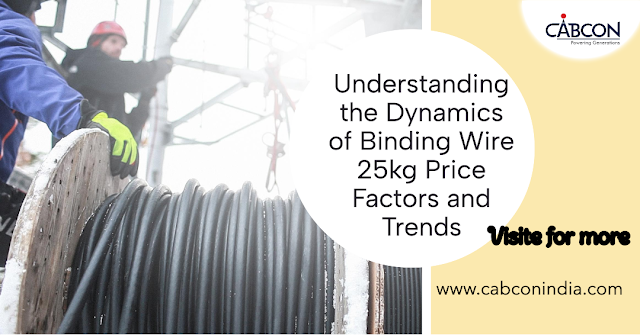Binding wire, also known as tie wire or bale wire, is an essential construction material used for securing and tying together reinforcement bars (rebars) in concrete structures. As with any commodity, the price of binding wire is influenced by various factors, and understanding these dynamics is essential for construction professionals, builders, and buyers. In this blog, we will know more about the factors that impact the binding wire 25kg price and explore the current trends in the market.
Factors Influencing Binding Wire 25kg Price
1.
Raw Material Costs:
The primary material used in manufacturing
binding wire is steel. The price of steel is subject to fluctuations in the
global market due to factors such as supply and demand, geopolitical events,
and raw material availability. Any significant changes in the cost of steel can
directly impact the binding wire price.
2.
Market Demand:
Construction and infrastructure projects
drive the demand for binding wire. During periods of increased construction
activity, the demand for binding wire rises, leading to potential price
increases. Conversely, during economic slowdowns or low construction activity,
the demand may decrease, leading to stable or lower prices.
3.
Manufacturing Processes:
The manufacturing process of binding
wire for construction involves drawing steel through dies to
achieve the desired diameter. Any changes in the production process, energy
costs, or technological advancements can influence the overall cost of
manufacturing, which may subsequently affect the binding wire price.
4.
Transportation Costs:
This type of wire is distributed and sold
in various regions, and transportation costs can vary depending on the distance
between the manufacturing facility and the end market. Fluctuations in fuel
prices and transportation fees can impact the final price of the product.
5.
Currency Exchange Rates:
For countries that import or export binding
wire, fluctuations in currency exchange rates can influence the cost of the
product. A weaker local currency relative to the currency of the exporting
country may lead to higher import costs and vice versa.
Current trends
1.
Volatility in Steel
Prices:
Historically, steel prices have been
subject to fluctuations. During times of increased demand for steel, such as
rapid urbanization and infrastructure development, the binding wire
manufacturer price tends to rise. Conversely, in times of economic
slowdown or oversupply of steel, prices might stabilize or even decrease.
2.
Construction Industry
Growth:
The construction industry’s performance
heavily impacts the demand for these wires. In periods of robust growth and
high construction activity, the demand for binding wire increases, leading to
potential price escalations.
3.
Sustainability and
Recycling Efforts:
The global push for sustainability and
eco-friendly practices has influenced the construction industry as well. Some
manufacturers may opt for sustainable sourcing of raw materials and
eco-friendly manufacturing processes. While these practices might incur
additional costs, they can also influence the price of binding wire.
4.
Market Competition:
The market is likely to be influenced by
the level of competition among manufacturers and suppliers. Higher competition
may drive manufacturers to keep prices competitive to retain or gain market
share.
5.
Regulatory Changes:
Changes in government regulations and
policies related to the steel industry or construction sector can impact the
production and distribution costs of spiral binding wire.
For example, stricter environmental regulations might lead to additional
compliance costs for manufacturers, which could be reflected in the product
price.
6.
Seasonal Variations:
In some regions, construction activity and
demand for binding wire might exhibit seasonal patterns. During peak construction
seasons, the demand for these wires may increase, leading to potential price
fluctuations.
7.
Inflation and Currency
Depreciation:
Inflationary pressures and currency
depreciation can erode the purchasing power of consumers and increase the
production costs for manufacturers. In such scenarios, the binding wire price
may increase to offset rising expenses.
The price of these commercial wires in a
25kg bundle is subject to various factors, including raw material costs, market
demand, manufacturing processes, transportation expenses, and currency exchange
rates. Understanding these dynamics is essential for construction professionals
and buyers to make informed decisions and manage budget expectations for their
projects. As market conditions and trends continually evolve, it is crucial to
keep abreast of the latest developments to gain a comprehensive understanding
of the binding wire price. Consulting with reputable suppliers and industry
experts can be valuable in navigating these fluctuations and making
well-informed choices.

Comments
Post a Comment